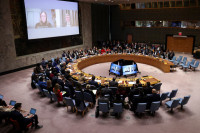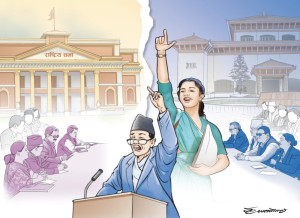Columns
Growing pains or down a rabbit hole?
Kathmandu should demonstrate credible commitment to transfer power to the provinces.
Gambhir Bhatta & Sameer Khatiwada
Before the split in the erstwhile Nepal Communist Party and subsequently, in the CPN-UML, all seven provinces had seven ministers each. Following the formation of the five-party alliance which toppled the UML governments in the provinces, there has been competition among the provincial governments to expand the number of ministries and ministers. Bagmati province, which has the largest number of Provincial Assembly members, provides a case in point. Before Chief Minister Rajendra Pandey took over from Asta Laxmi Shakya, the province had eight ministries. Now it has 14 ministries and 18 ministers. We have all seen the infamous picture of the provincial government building with each ministry’s signboard hanging from the windows.
The number of provincial ministers allowed by the constitution is up to 20 percent of the total assembly members. Party leaders claim that expanding the cabinet shouldn’t be an issue so long as the number of ministers does not go beyond the constitutional limit. Bagmati province has 120 members, which means it can have up to 24 ministers. And chief ministers have found splitting ministries an easy way to accommodate different political parties and their leaders in government. Our experience of the last five years reveals several challenges to federalism in Nepal. If we do not address them in time, there may well be a groundswell of opinion that federalism has failed in the country.
Unfinished tasks
We need to start by doing a review of the existing conditions, endowments, processes and benchmarks in all facets of public service delivery, including the existing state of public utilities, production centres, financial institutions and mechanisms and the state of systemic capabilities in the sub-national governments. Amendments need to be made to federal laws that are at the heart of federalism: Inter-Governmental Fiscal Arrangement Act and Local Government Operation Act. Federal laws related to education and public service are yet to be formulated for the central government, without which lower level laws cannot be put into place.
Federalism in Nepal has enhanced the scope for contestability of policy ideas at all levels; yet actors such as the bureaucracy (at the central level), local level political leaders, civil society and even the media are deemed to have been "captured" by the political parties which have so dominated public life in Nepal. Writing the constitution took almost a decade, but that appears to have been the easy part. Implementation of its provisions and institutionalisation of federalism across all levels of government and in society has proven to be much more difficult. A close look at the views expressed by political leaders shows the prevalence of what can be termed "centralised federalism". This means that many political, administrative and fiscal decisions continue to be made in Kathmandu. And the very high degree of reliance of local governments on federal grants means, in essence, that the power of the purse strings still resides in the central government.
So, what are the issues that are evident at the local level? Sub-national governments have not fully adhered to the principles of transparency as there is a general failure to publish programmes and budgets in a timely manner besides providing adequate public disclosure of government spending. The provinces have been unable to frame legislation (such as on civil service) since the central government has not been able to put the relevant framework legislation in place. Capacity constraints at the local level are obvious. The provinces have been unable to spend more than 70 percent of their annual budgets, and most of this spending is done in a rush in the last quarter.
If federalism is to succeed, the accountability of governments needs to be enhanced for which information will play a critical role. This is singularly missing in local governments. A recent World Bank and UNDP capacity needs assessment pointed out that almost half of the local assemblies do not receive actionable information from the executive on the status of development projects and programmes.
A central part of the institutionalisation of federalism has to do with the matter of resource transfers from the federal to the sub-national governments. According to the International Monetary Fund, Nepal has one of the highest levels of vertical fiscal imbalance in the world. A whopping 93 percent of the 753 local governments in Nepal have an own-source revenue level of 10 percent or less. So the local governments rely substantially on grants and resource transfers from the centre in order to finance their current and capital expenditures. A deeper analysis will need to start with a focus on the role of the National Natural Resources and Fiscal Commission. On the specific aspect of budgeting at the sub-national level, it is felt that the budgets are being influenced by political interests. It has been reported that more than 15 percent of the resources are allocated under the miscellaneous heading. The provincial governments have also not adhered to the National Planning Commission guidelines on allocating small budget programmes to local governments.
The central government needs to demonstrate credible commitment to the provisions of the federal form of government. We need not travel much farther than India to see how this is put into practice in the work of the Finance Commissions with respect to the financial relations between New Delhi and the state governments. Central level bureaucrats and politicians find it difficult to cede authority to the sub-national governments. This has been amply demonstrated in Nepal where bureaucrats based in Kathmandu often revert to type while discussing what needs to happen at the sub-national level.
In all countries where federalism is working more or less smoothly, the importance of institutions that enforce the rules of the game is patently obvious. In Australia, the National Cabinet brings together the federal prime minister and all state and territory premiers and chief ministers to work out issues of national interest. Despite political differences, they work together well. We are yet to reach that degree of collaborative and functional relationships between the federal and provincial governments. Developing such institutions may be a long-term affair in Nepal, but the hard yards need to be taken now.
Uncharted territory
State restructuring on this scale is uncharted territory for Nepal, and ensuring a smooth transition is a daunting task. For a country like Nepal with its pre-existing set of development challenges and binding constraints, pulling this off was always going to be difficult. If we expected federalism to deliver on its promises within five short years, then the system has failed miserably. But that expectation never made sense to begin with. Looking at our experience in the last five years, the benefits of federalism in Nepal outweigh the costs. Examples from other developing countries show that the challenges to federalism faced by Nepal are no different. Building institutions takes time. The more time we spend arguing over the basic governance structure of our country, the less time we have for implementing policies and programmes for economic growth and job creation.
Having said that, it also needs to be mentioned that unless successive central governments demonstrate credible commitment to the federalism experiment, and all that it implies for transfer of power to the sub-national levels, it will increasingly look like we are going down a rabbit hole. To date, that degree of commitment has unfortunately not been evident.




 16.2°C Kathmandu
16.2°C Kathmandu
















